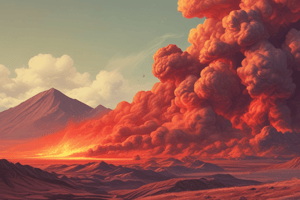Podcast
Questions and Answers
What is the definition of a caldera?
What is the definition of a caldera?
- A bowl-shaped structure formed when a volcano collapses in on itself (correct)
- A pile of volcanic ash accumulated around a vent
- The summit of a volcano
- A small crater formed during minor eruptions
Which part of a volcano is specifically described as the highest point?
Which part of a volcano is specifically described as the highest point?
- Slope
- Summit (correct)
- Crater
- Base
What primarily causes a caldera to form?
What primarily causes a caldera to form?
- Explosive eruptions followed by magma chamber drainage (correct)
- Lateral blasts during an eruption
- Continuous lava flow out of the volcano
- Accumulation of tephra around the vent
What is NOT directly associated with volcanic eruptions?
What is NOT directly associated with volcanic eruptions?
Which term refers to the outer lower part of the volcano?
Which term refers to the outer lower part of the volcano?
What occurs at a secondary site on the side of a volcano during an eruption?
What occurs at a secondary site on the side of a volcano during an eruption?
Which of the following materials might accumulate around a volcanic vent?
Which of the following materials might accumulate around a volcanic vent?
What are pyroclastic density currents typically classified as?
What are pyroclastic density currents typically classified as?
Flashcards
Summit
Summit
The highest point of a volcano.
Slopes
Slopes
The sides or flanks of a volcano that extend outward from the main vent.
Base
Base
The lower outer part of a volcano.
Crater
Crater
Signup and view all the flashcards
Caldera
Caldera
Signup and view all the flashcards
Magma
Magma
Signup and view all the flashcards
Vent
Vent
Signup and view all the flashcards
Tephra
Tephra
Signup and view all the flashcards
Study Notes
Volcano Structure and Formation
- Volcanoes are vents, hills, or mountains where molten rock and gas are ejected.
- They can also be craters, depressions, or hills formed by the removal or accumulation of ejected materials.
- Key parts of a volcano:
- Summit: Highest point.
- Slopes: Sides radiating from the vent.
- Base: Lower outer part.
- Crater: Funnel-shaped opening at the summit.
- Aler: Part of the wall that collapses after an eruption.
Caldera Formation
- A caldera is a large, bowl-shaped structure, much larger than a crater.
- Calderas form when a volcano collapses inward.
- This happens when an eruption drains the magma chamber beneath the volcano, removing the support holding the volcano's structure.
- This causes the top and sides of the volcano to collapse into the drained magma chamber to form the caldera.
- Activity might resume later, perhaps at a new location, forming a different volcanic landform or possibly creating a new crater within the caldera.
Volcanic Eruptions and Processes
- Magma rises from a magma chamber through vents or conduits.
- Eruptions occur at the volcano's summit crater (central eruption), or at a secondary site on the volcano (flank eruption).
- Erupted materials accumulate around the vent to form the volcanic mountain
- Ejected material can be lava flows (solidified lava) or various sized fragments.
Volcanic Hazards
-
Direct Hazards:
- Lava flows
- Tephra fall (ashfall) and ballistic projectiles
- Pyroclastic density currents (PDCs)
- Lateral blasts
- Volcanic gases
-
Indirect Hazards:
- Lahars (volcanic mudflows) and flooding
- Debris avalanches and landslides
- Volcanic tsunamis
- Ground deformation (subsidence, fissuring)
- Secondary explosions
- Secondary PDCs and ashfall
Studying That Suits You
Use AI to generate personalized quizzes and flashcards to suit your learning preferences.




